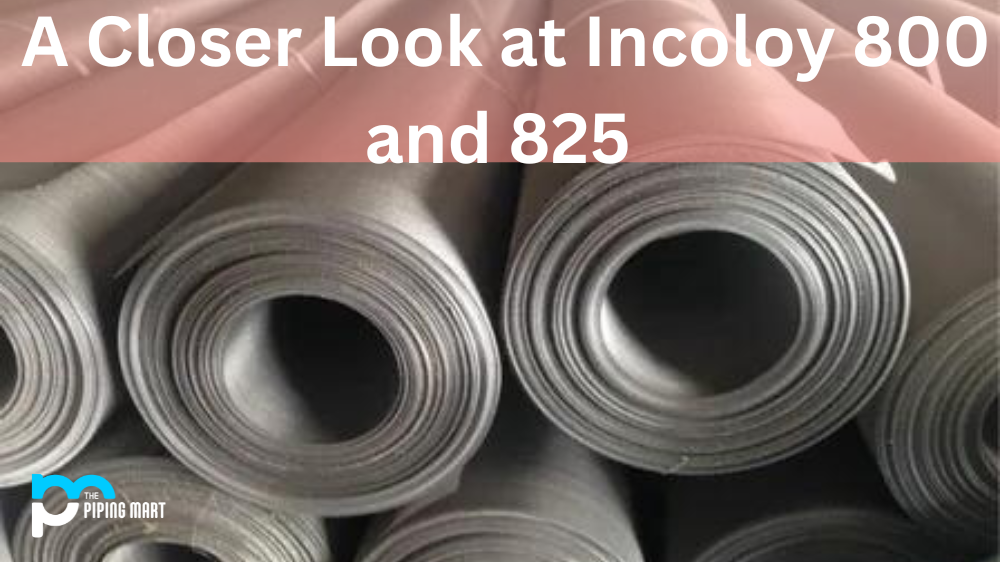Incoloy is an alloy made up of nickel, iron, chromium, and other elements. It is a type of stainless steel with superior corrosion resistance, making it highly sought after in various industries. Two popular varieties of Incoloy are 800 and 825. Let’s take a closer look at the differences between these two alloys.
Incoloy 800 Vs Incoloy 825
Incoloy 800 and Incoloy 825 are both nickel–based alloys used in a variety of applications. Incoloy 800 is a nickel–iron–chromium alloy that is known for its good strength and excellent resistance to oxidation and carburization in high–temperature atmospheres. Incoloy 825 is a nickel–iron–chromium–molybdenum alloy that is known for its excellent corrosion resistance in a wide range of environments.
In terms of composition, Incoloy 800 contains 36–46% nickel, 19–23% chromium, 0.15–0.60% aluminum, 0.15–0.60% titanium, and 0.15–0.60% copper. Incoloy 825 contains 38–46% nickel, 19–23% chromium, 2.5–3.5% molybdenum, 1.5–3.0% iron, and 0.6–1.2% manganese.
In terms of mechanical properties, Incoloy 800 has a tensile strength of 80 ksi (550 MPa) and a yield strength of 30 ksi (205 MPa). Incoloy 825 has a tensile strength of 80 ksi (550 MPa) and a yield strength of 35 ksi (240 MPa). In terms of temperature resistance, Incoloy 800 can be used up to 1200°F (650°C), while Incoloy 825 can be used up to 1800°F (980°C).
Overall, Incoloy 800 is better suited for applications that require good strength and oxidation resistance at high temperatures, while Incoloy 825 is better suited for applications that require excellent corrosion resistance in a wide range of environments.
Chemical Composition
Incoloy 800 is composed primarily of nickel (31%) and chromium (19%). Other elements present in Incoloy 800 include manganese, silicon, carbon, aluminum, titanium, copper, sulfur, and phosphorus. The chemical composition also has small amounts of molybdenum and niobium to improve its corrosion resistance properties against carburization and oxidation at high temperatures. On the other hand, Incoloy 825 contains more nickel (38%) than chromium (20%). It also contains an additional element—molybdenum—which helps significantly improve its corrosion resistance to sulfurous acids such as hydrochloric acid.
Usage & Applications
Incoloy 800 is ideal for applications where high-temperature strength is required since it maintains its good mechanical properties even when exposed to temperatures well above 1000°F (540°C). This makes it suitable for use in heat exchangers and steam generators for power plants; petrochemical equipment; boilers; nuclear engineering components; oil refinery equipment; heat-treating equipment; oven linings; furnace components; incinerators; welding filler wire; boiler tubes – flues – breeching; tube sheets and more. On the other hand, Incoloy 825 boasts superior corrosion resistance properties compared to Incoloy 800 thanks to the addition of molybdenum into its chemical composition. As such, this alloy is often used in applications that require exposure to corrosive environments, such as chemical processing plants or process vessels containing chloride solutions with low pH levels. It can also be used for seawater piping systems due to its excellent pitting resistance in seawater.
Conclusion:
Incoloy 800 and 825 offer excellent performance in their respective applications due to their superior corrosion resistance properties. Knowing which alloy suits your requirements best will help you make an informed decision when selecting one over the other. Knowing the difference between both alloys can help engineers make sure they choose the right material for their needs without sacrificing quality or performance. With the right knowledge about these two alloys, you can ensure that you select an appropriate material safely and efficiently for your application!

Abhishek is a seasoned blogger and industry expert, sharing his insights and knowledge on various topics. With his research, Abhishek offers valuable insights and tips for professionals and enthusiasts. Follow him for expert advice on the latest trends and developments in the metal industry.




